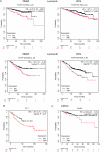PV-1: a novel molecular prognostic marker of distant metastases in various solid tumors
- PMID: 40691302
- PMCID: PMC12423316
- DOI: 10.1038/s44321-025-00277-5
PV-1: a novel molecular prognostic marker of distant metastases in various solid tumors
Abstract
Identification of biomarkers for the hematogenous spreading of cancer cells is of paramount prognostic and therapeutic value. We showed that Plasmalemma Vesicle Associated Protein-1 (PV-1) serves as a marker of increased blood vessel permeability and is an independent predictor of colorectal cancer dissemination. This study investigates whether PV-1 can also act as a prognostic marker for distant metastases in other solid tumors. We analyzed samples from 134 patients: 30 luminal breast cancer (BC), 52 clear cell renal cell carcinoma (ccRCC), and obtained preliminary data from 52 soft tissue sarcomas (STS). A higher frequency of PV-1+ endothelial cells was significantly associated with metastatic progression in luminal BC and ccRCC. Moreover, the frequency of PV-1+ cells emerged as a significant prognostic factor for metastasis-free survival in both luminal BC and ccRCC. Further research is needed to validate PV-1's prognostic utility, as including it at diagnosis may change the management of these patients and should allow stratification for more aggressive therapies or for closer follow-ups to promptly intervene in case of metastases development.
Keywords: Biomarker; Endothelial Permeability; Metastasis-free Survival; PV-1 (PLVAP); Solid Tumors.
© 2025. The Author(s).
Conflict of interest statement
Disclosure and competing interests statement. Maria Rescigno is an EMM editorial board member, EMBO Member and EMBO Council Chair. This has no bearing on the editorial consideration of this article for publication. The remaining authors declare no competing interests.
Figures







References
-
- Bertocchi A, Carloni S, Ravenda PS, Bertalot G, Spadoni I, Lo Cascio A, Gandini S, Lizier M, Braga D, Asnicar F et al (2021) Gut vascular barrier impairment leads to intestinal bacteria dissemination and colorectal cancer metastasis to liver. Cancer Cell 39:708–724.e711 - PubMed
-
- Capitanio U, Montorsi F (2016) Renal cancer. Lancet 387:894–906 - PubMed
-
- Cossetti RJ, Tyldesley SK, Speers CH, Zheng Y, Gelmon KA (2015) Comparison of breast cancer recurrence and outcome patterns between patients treated from 1986 to 1992 and from 2004 to 2008. J Clin Oncol 33:65–73 - PubMed
MeSH terms
Substances
Grants and funding
LinkOut - more resources
Full Text Sources
Medical
Research Materials

